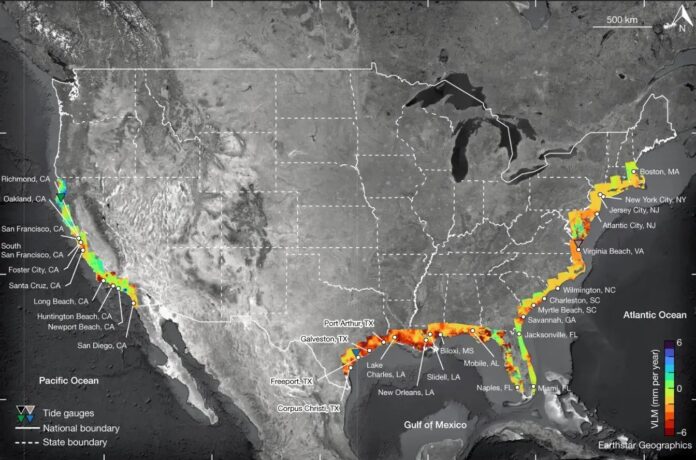By: Aarav Sapa
The gradual increase in seawater levels has contributed to the gradual sinking of coastal cities in the United States. This problem continues to be a silent problem that risks flooding and the livelihood or lifestyle of locals in these cities. Researchers from different universities in the US, Canada, England, and India have all reported and created a study to examine the potential impacts of subsidence in 32 cities along the Atlantic, Gulf, and Pacific Coasts. For instance, New York City, San Francisco, and many other U.S. coastal cities, are at risk of sinking into the ocean. The study showed that hundreds of thousands of residents will eventually be displaced by 2050 when sea levels are projected to have risen by at least 10 inches.
Most of this subsidence occurs along the Gulf Coast, most likely because sea levels have risen over the decade and are happening more quickly than in other regions. A recent reporter who reported the study states, “Even if climate change mitigation efforts succeed in stabilizing temperature in the future decades, sea levels will continue to rise due to the continuing response of oceans to past warming.” In addition, the study later found that the 32 cities are projected to have a population of about 25 million by 2050, along with about 10 million properties valued at roughly $12 trillion. Moreover, along the Gulf Coast, subsidence is projected to account for nearly 30 percent of total flooding by 2050, a more significant rate than on the Atlantic and Pacific coasts. The study states that airports and refineries are anticipated to be among the exposed infrastructure along the Gulf Coast.
Although some precautionary measures, such as flood-control structures, have been placed, many claim they will only be practical in the short term. Their effectiveness is only partially guaranteed and is only a temporary solution. However, a more proactive approach that individuals that were part of the study recommend is to limit the impacts of sea-level rise. Methods include using nature-based protections such as marshes and mangroves, structural protections such as the Ike Dike, land-raising and subsidence control, strategic land-use planning to reduce vulnerability, and stringent climate-change policies that keep carbon emissions low. Nevertheless, land subsidence continues to be a problem in our world and needs to be addressed as soon as possible.










